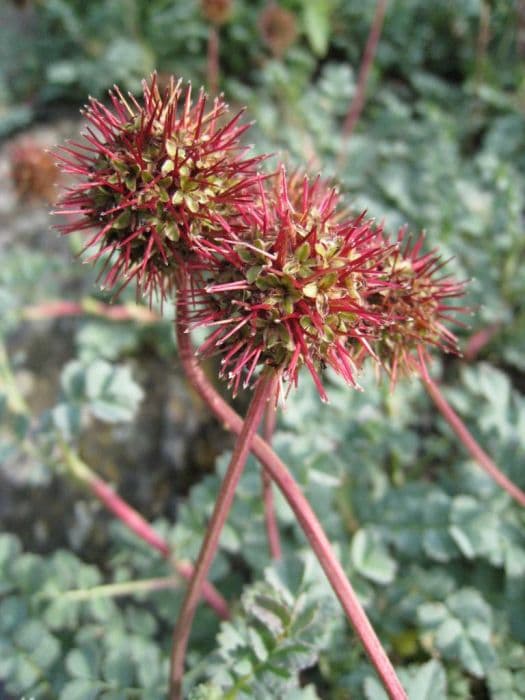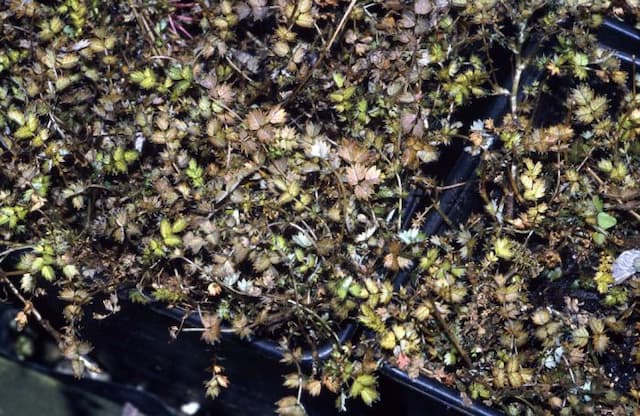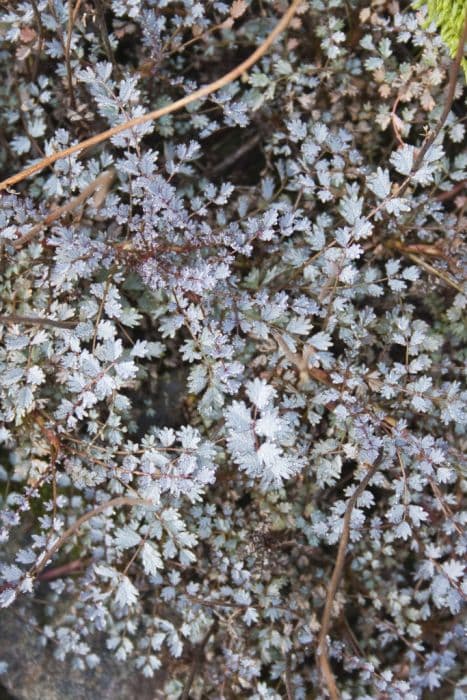Queen of the Prairie Filipendula rubra 'Venusta'

ABOUT
The plant commonly known as Queen of the Prairie 'Venusta' typically boasts a delightful, lush appearance with a range of striking features. It is characterized by deep green, lobed leaves with a slightly coarse texture, which form an attractive backdrop for its showy flowers. These blossoms are fluffy and cloud-like, presenting a soft pink to rosy color palette. They cluster together in large, branching panicles, which resemble feathered plumes waving gently in the breeze. The individual flowers are small yet numerous, creating an abundant and frothy display that can add a touch of whimsy to any garden setting. The leaves, stems, and flowers together grant the plant a delicate, yet visually robust aesthetic. As the plant develops, it begins to form an impressive clump, with its foliage creating a dense, bushy mound. The striking flower panicles appear atop lengthy stems, which elegantly rise above the leaves during the blooming season. The overall form of the plant is both upright and arching, with the flowering stems creating a fountain-like effect. As the season progresses, the flowers may fade to a pale pink or creamy white, offering a prolonged period of visual interest. In the fall, the foliage may acquire a golden hue, contributing to the autumnal beauty of the landscape. Overall, Queen of the Prairie 'Venusta' is a charming and graceful plant that can create a soft, romantic atmosphere in gardens and naturalized areas.
About this plant
 Names
NamesFamily
Rosaceae
Synonyms
Queen Of The Prairie, Venusta Meadowsweet, Venusta Queen Of The Prairie, Purple Meadowsweet
Common names
Ulmaria rubra (Hill) Fries, Spiraea ulmaria var. rubra (Hill) W.D.J.Koch, Spiraea venusta Wender., Filipendula ulmaria (L.) Maxim. var. rubra (Hill) Schinz & Thell., Spiraea palmata Gilib.
 Toxicity
ToxicityTo humans
Queen of the Prairie (Filipendula rubra 'Venusta') is not commonly known to be toxic to humans. There is limited information on the plant causing any severe adverse effects if ingested. However, like with any plant not typically used for food, individual allergies or sensitivities may exist, leading to mild gastrointestinal upset or allergic reactions in some individuals.
To pets
Queen of the Prairie (Filipendula rubra 'Venusta') is not widely reported to be toxic to pets. There is no widespread documentation of this plant causing severe toxicity in domestic animals; pets might experience mild gastrointestinal discomfort if they consume large amounts of the plant. Always monitor your pets around plants and consult a veterinarian if you notice unusual symptoms after ingestion.
 Characteristics
CharacteristicsLife cycle
Perennials
Foliage type
Deciduous
Color of leaves
Green
Flower color
Pink
Height
4-6 feet (1.2-1.8 meters)
Spread
2-4 feet (0.6-1.2 meters)
Plant type
Herb
Hardiness zones
3-8
Native area
North America
Benefits
 General Benefits
General Benefits- Aesthetic Appeal: The Queen of the Prairie adds vibrant color and texture to gardens with its deep pink flowers and lush green foliage.
- Wildlife Attraction: It attracts a variety of pollinators, including butterflies and bees, which can help pollinate the surrounding plants.
- Easy Maintenance: Once established, it is relatively low maintenance, requiring minimal care beyond occasional watering and pruning.
- Tolerance to Moisture: This plant thrives in moist conditions, making it suitable for planting in areas with wet soils or near water features.
- Drought Resistance: Despite its preference for moisture, it can tolerate periods of drought, making it versatile in different weather conditions.
- Naturalizing Effect: It spreads by rhizomes and can form large, natural-looking drifts, ideal for a cottage or wildflower garden.
- Tall Structure: Its height can provide structure and a vertical element in garden design, acting as a backdrop for shorter plants.
 Medical Properties
Medical PropertiesThis plant is not used for medical purposes.
 Air-purifying Qualities
Air-purifying QualitiesThis plant is not specifically known for air purifying qualities.
 Other Uses
Other Uses- Filipendula rubra 'Venusta', also known as Queen of the Prairie, can be used in floral arrangements due to its showy, pink flower clusters, providing a natural and whimsical aesthetic.
- The plant can serve as a natural dye source, where different parts can yield various shades of yellow or green, depending on the mordant used.
- Its tall and sturdy stems can be incorporated into garden structural designs to support lighter, more delicate plants that need assistance.
- The dried seed heads of Queen of the Prairie can be used in crafts such as wreath-making or dried flower arrangements for an interesting textural element.
- Insect hotels can be created using the hollow stems after the plant has died back, providing safe nesting spaces for beneficial insects.
- The plant's ability to withstand wet conditions makes it suitable for rain garden plantings, helping to manage water runoff in landscapes.
- As an addition to a sensory garden, the soft foliage and fuzzy stems provide a unique tactile experience.
- The dense growth habit makes Queen of the Prairie a good choice for creating living screens or informal hedges in garden settings.
- The leaves can be pressed and used in botanical prints or art projects, capturing the intricate venation patterns.
- Its presence in a wildlife garden can attract pollinators like bees and butterflies, supporting local ecosystems.
Interesting Facts
 Feng Shui
Feng ShuiThe Queen of the Prairie is not used in Feng Shui practice.
 Zodiac Sign Compitability
Zodiac Sign CompitabilityThe Queen of the Prairie is not used in astrology practice.
 Plant Symbolism
Plant Symbolism- Feminine charm and attractiveness: The common name for Filipendula rubra 'Venusta' is Queen of the Prairie, which conveys an air of regal beauty and grace, often associated with feminine energy.
- Elegance and grace: The graceful and tall stalks topped with soft pink flowers suggest poise and a dignified presence, qualities often appreciated in a variety of cultural contexts.
- Uniqueness: With its unique pink cloud-like blooms, Queen of the Prairie symbolizes the idea of standing out from the crowd and celebrating one's individuality.
- Prosperity and abundance: The lush, full appearance of the plant's foliage and flowers can represent a sense of richness and fullness in life, hinting at prosperity.
 Water
WaterQueen of the Prairie should be watered deeply but infrequently to mimic natural conditions, as it prefers moist soils. Ensure the plant receives about 1 inch of water weekly during its growing season, especially if the weather is dry. To avoid mildew and other fungal diseases, water at the base of the plant rather than from above. During drought conditions, water the plant using roughly 0.5 gallons per square foot every week. Cut back on watering as the plant becomes dormant in the fall.
 Light
LightQueen of the Prairie thrives best in full sun to partial shade. It performs well in locations that receive at least 6 hours of direct sunlight daily but can tolerate some afternoon shade. Avoid planting it in deep shade as it may impact the plant's blooming and overall vitality.
 Temperature
TemperatureQueen of the Prairie is cold hardy and can survive winter temperatures down to -30°F, making it suitable for many temperate climates. It grows best in temperatures ranging from 60°F to 70°F during the growing season. Extreme heat above 85°F may stress the plant, especially if it is situated in full sun without adequate moisture.
 Pruning
PruningPruning Queen of the Prairie is generally done to remove spent flowers and encourage a second, although smaller, bloom period. Cut back the stalks to the ground in late winter or early spring before new growth starts. Pruning can also help maintain an attractive shape and prevent the plant from becoming too leggy.
 Cleaning
CleaningAs needed
 Soil
SoilQueen of the Prairie (Filipendula rubra 'Venusta') thrives in moist, well-draining soil with high organic matter content. The ideal soil pH for this plant ranges from 6.0 to 7.0. A mix of garden loam, peat, and sand can make an excellent growing medium for optimal growth and flowering.
 Repotting
RepottingQueen of the Prairie does not typically require frequent repotting as it is primarily grown as a perennial garden plant. It should only be divided or repotted when the clumps become overcrowded, which may be every 3-4 years to maintain its vigor.
 Humidity & Misting
Humidity & MistingQueen of the Prairie prefers moderate to high humidity levels. However, as an outdoor plant, it is generally tolerant of the ambient humidity found in its growing zones and does not require specific humidity adjustments.
 Suitable locations
Suitable locationsIndoor
Queen of the Prairie struggles indoors; prefers full sun, outdoors.
Outdoor
Place in full sun to part shade, moist soil, space 2-3 feet apart.
Hardiness zone
3-8 USDA
 Life cycle
Life cycleThe life of the Queen of the Prairie (Filipendula rubra 'Venusta') begins when its seeds germinate in late spring or early summer, preferably in moist soil. Seedlings develop into young plants with deeply lobed leaves, gradually establishing a robust root system. As the plants mature, they form clumps with tall, erect stems reaching up to 6 feet tall, and in midsummer, they produce large, airy panicles of deep pink flowers that are attractive to pollinators such as bees and butterflies. After flowering, the plants set seeds, which can be dispersed by wind or fall to the ground nearby, capable of germinating to produce new plants. In the autumn, the above-ground part of the plant dies back, while the root system remains alive, allowing the plant to survive the winter and resprout the following spring. Over time, the Queen of the Prairie can spread through its rhizomes to form larger clonal colonies, thus continuing its life cycle.
 Propogation
PropogationPropogation time
Spring-Early Summer
The Queen of the Prairie, or Filipendula rubra 'Venusta', is typically propagated by division, which is the most popular method for this perennial plant. The best time for dividing the plant is either in early spring as the plants emerge, or in the fall when the plant begins to go dormant. To propagate by division, carefully dig up the clump of Queen of the Prairie, preserving as much of the root system as possible. The clump should then be divided into smaller sections, ensuring each section has several growth buds. These individual sections can then be replanted at the same depth they were growing previously, spaced about 2 to 3 feet apart to accommodate future growth. It's important to water the new transplants well to help establish the new roots.









